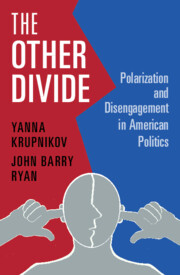Book contents
- The Other Divide
- The Other Divide
- Copyright page
- Dedication
- Contents
- Figures
- Tables
- Preface and Acknowledgments
- 1 A House Divided against Itself?
- 2 Subtleties of Partisan Division
- 3 Beyond Political Interest
- 4 The Deeply Involved Are Different
- 5 Bubbles of Involvement
- 6 Perceptions of the Most Sacred Duty
- 7 A New Form of Self-Expression
- 8 The Voice of Which People?
- 9 Middle Grove
- Appendix
- References
- Index
1 - A House Divided against Itself?
Published online by Cambridge University Press: 19 January 2022
- The Other Divide
- The Other Divide
- Copyright page
- Dedication
- Contents
- Figures
- Tables
- Preface and Acknowledgments
- 1 A House Divided against Itself?
- 2 Subtleties of Partisan Division
- 3 Beyond Political Interest
- 4 The Deeply Involved Are Different
- 5 Bubbles of Involvement
- 6 Perceptions of the Most Sacred Duty
- 7 A New Form of Self-Expression
- 8 The Voice of Which People?
- 9 Middle Grove
- Appendix
- References
- Index
Summary
Much of the modern study of mass political behavior in the United States often returns to three books released during the Eisenhower administration. Voting by Berelson, Lazarsfeld, and McPhee (1954) approached its subject from a sociological perspective. Anthony Downs’ (1957) An Economic Theory of Democracy is the foundational study of political decision-making from the rational-choice perspective. The American Voter by Campbell et al. (1960) pioneered the use of the mass survey for political research. These approaches to studying politics are ubiquitous now, but, at the time, these were pathbreaking methodological advances. The authors of these books were to the study of politics what Chuck Berry, Little Richard, and Elvis Presley were to popular music.
- Type
- Chapter
- Information
- The Other Divide , pp. 1 - 22Publisher: Cambridge University PressPrint publication year: 2022

